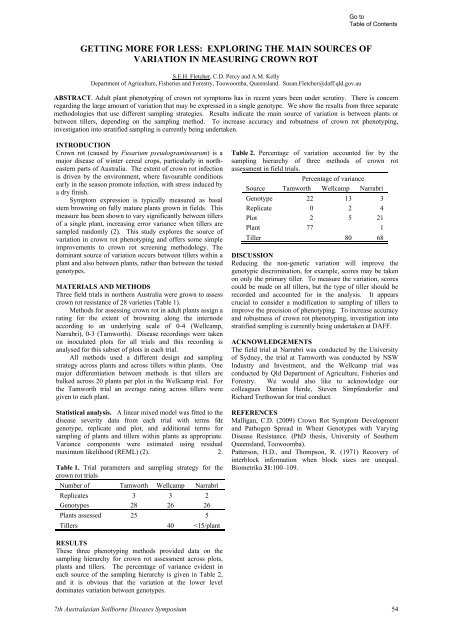invit - Australasian Plant Pathology Society
invit - Australasian Plant Pathology Society
invit - Australasian Plant Pathology Society
You also want an ePaper? Increase the reach of your titles
YUMPU automatically turns print PDFs into web optimized ePapers that Google loves.
Go to<br />
Table of Contents<br />
GETTING MORE FOR LESS: EXPLORING THE MAIN SOURCES OF<br />
VARIATION IN MEASURING CROWN ROT<br />
S.E.H. Fletcher, C.D. Percy and A.M. Kelly<br />
Department of Agriculture, Fisheries and Forestry, Toowoomba, Queensland. Susan.Fletcher@daff.qld.gov.au<br />
ABSTRACT. Adult plant phenotyping of crown rot symptoms has in recent years been under scrutiny. There is concern<br />
regarding the large amount of variation that may be expressed in a single genotype. We show the results from three separate<br />
methodologies that use different sampling strategies. Results indicate the main source of variation is between plants or<br />
between tillers, depending on the sampling method. To increase accuracy and robustness of crown rot phenotyping,<br />
investigation into stratified sampling is currently being undertaken.<br />
INTRODUCTION<br />
Crown rot (caused by Fusarium pseudograminearum) is a<br />
major disease of winter cereal crops, particularly in northeastern<br />
parts of Australia. The extent of crown rot infection<br />
is driven by the environment, where favourable conditions<br />
early in the season promote infection, with stress induced by<br />
a dry finish.<br />
Symptom expression is typically measured as basal<br />
stem browning on fully mature plants grown in fields. This<br />
measure has been shown to vary significantly between tillers<br />
of a single plant, increasing error variance when tillers are<br />
sampled randomly (2). This study explores the source of<br />
variation in crown rot phenotyping and offers some simple<br />
improvements to crown rot screening methodology. The<br />
dominant source of variation occurs between tillers within a<br />
plant and also between plants, rather than between the tested<br />
genotypes.<br />
MATERIALS AND METHODS<br />
Three field trials in northern Australia were grown to assess<br />
crown rot resistance of 28 varieties (Table 1).<br />
Methods for assessing crown rot in adult plants assign a<br />
rating for the extent of browning along the internode<br />
according to an underlying scale of 0-4 (Wellcamp,<br />
Narrabri), 0-3 (Tamworth). Disease recordings were taken<br />
on inoculated plots for all trials and this recording is<br />
analysed for this subset of plots in each trial.<br />
All methods used a different design and sampling<br />
strategy across plants and across tillers within plants. One<br />
major differentiation between methods is that tillers are<br />
bulked across 20 plants per plot in the Wellcamp trial. For<br />
the Tamworth trial an average rating across tillers were<br />
given to each plant.<br />
Table 2. Percentage of variation accounted for by the<br />
sampling hierarchy of three methods of crown rot<br />
assessment in field trials.<br />
Percentage of variance<br />
Source Tamworth Wellcamp Narrabri<br />
Genotype 22 13 3<br />
Replicate 0 2 4<br />
Plot 2 5 21<br />
<strong>Plant</strong> 77 1<br />
Tiller 80 68<br />
DISCUSSION<br />
Reducing the non-genetic variation will improve the<br />
genotypic discrimination, for example, scores may be taken<br />
on only the primary tiller. To measure the variation, scores<br />
could be made on all tillers, but the type of tiller should be<br />
recorded and accounted for in the analysis. It appears<br />
crucial to consider a modification to sampling of tillers to<br />
improve the precision of phenotyping. To increase accuracy<br />
and robustness of crown rot phenotyping, investigation into<br />
stratified sampling is currently being undertaken at DAFF.<br />
ACKNOWLEDGEMENTS<br />
The field trial at Narrabri was conducted by the University<br />
of Sydney, the trial at Tamworth was conducted by NSW<br />
Industry and Investment, and the Wellcamp trial was<br />
conducted by Qld Department of Agriculture, Fisheries and<br />
Forestry. We would also like to acknowledge our<br />
colleagues Damian Herde, Steven Simpfendorfer and<br />
Richard Trethowan for trial conduct.<br />
Statistical analysis. A linear mixed model was fitted to the<br />
disease severity data from each trial with terms for 1.<br />
genotype, replicate and plot, and additional terms for<br />
sampling of plants and tillers within plants as appropriate.<br />
Variance components were estimated using residual<br />
REFERENCES<br />
Malligan, C.D. (2009) Crown Rot Symptom Development<br />
and Pathogen Spread in Wheat Genotypes with Varying<br />
Disease Resistance. (PhD thesis, University of Southern<br />
Queensland, Toowoomba).<br />
maximum likelihood (REML) (2).<br />
2. Patterson, H.D., and Thompson, R. (1971) Recovery of<br />
interblock information when block sizes are unequal.<br />
Table 1. Trial parameters and sampling strategy for the Biometrika 31:100–109.<br />
crown rot trials<br />
Number of Tamworth Wellcamp Narrabri<br />
Replicates 3 3 2<br />
Genotypes 28 26 26<br />
<strong>Plant</strong>s assessed 25 5<br />
Tillers 40






![[Compatibility Mode].pdf](https://img.yumpu.com/27318716/1/190x135/compatibility-modepdf.jpg?quality=85)










